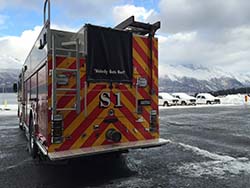By AUSTIN LOVE
Council Project Manager

In December, Alyeska Pipeline Service Company and the City of Valdez agreed to a plan for the Alyeska Fire Brigade and the Valdez Fire Department to work together to fight fires. This agreement defines the roles, relationships, jurisdiction, and responsibilities of the two parties in advance of an emergency. The agreement provides the framework for a coordinated emergency response within Valdez city limits.
The council supports the agreement as it will improve the ability of Alyeska Fire Brigade and the Valdez Fire Department to work in coordination both on and off Valdez Marine Terminal property. The agreement will help limit the possible loss of life and property in the event of an emergency, and decrease the potential environmental impacts of a fire at the terminal.
The agreement says that the Alyeska Fire Brigade may assist the Valdez Fire Department during an emergency within the city limits but off of Alyeska property. While not required to do so, Alyeska may provide emergency assistance to the City of Valdez, if a number of conditions are met. Foremost, their service must be specifically requested by the Valdez Fire Department and Alyeska must be able to maintain their minimum required fire and rescue staffing levels at the terminal even while assisting the City of Valdez. Alyeska will not charge the city for emergency services under this agreement.
